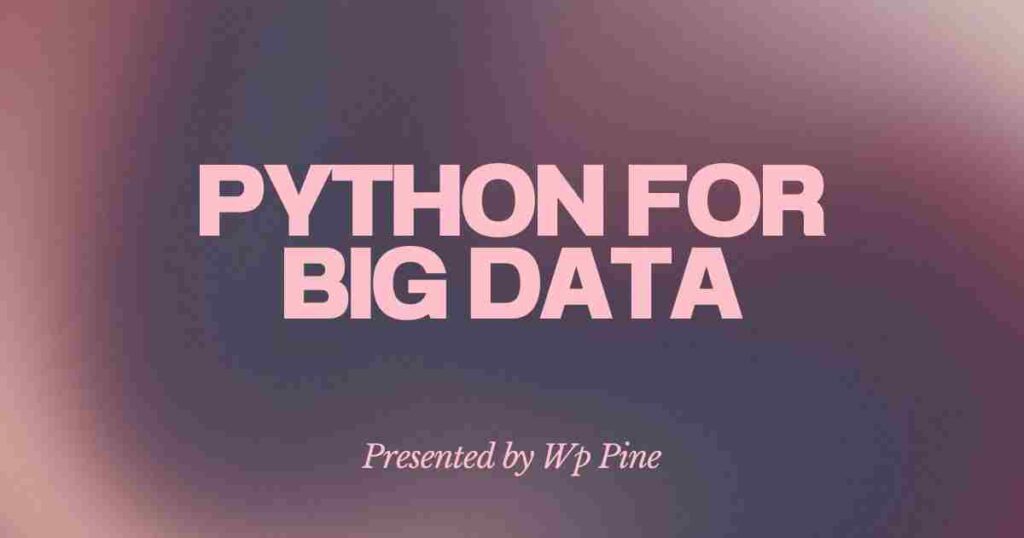Modern technology runs on data, often called “the new oil.” In this era, innovation and decision-making rely strongly on the ability to collect, analyze, and utilize data. Big Data is defined as vast, complex datasets produced at an incredible rate. Power tools and techniques are necessary to extract value from such data.
With its several advantages, Python is one of the tools selected to tap into the hidden potential of Big Data. Businesses and organizations seek simplicity in more complex data processing tasks offered by Python. This paper discusses why Python stands out for Big Data processing and appears more favorable than other programming languages.
What is Big Data?
Big Data
Big data is described by three primary dimensions, which are often referred to as the 3 Vs. These dimensions define the challenges and opportunities associated with managing and processing such data:
- Volume describes the sheer quantity of data generated every day. The sizes of this data are very large and most certainly difficult to store and analyze in any traditional database or system. Advanced tools and frameworks designed for scalability are required to manage such datasets.
- Velocity: Velocity refers to the speed at which data is collected and processes are performed. Modern systems now collect data in real-time, and analysis of the same should be instant to provide timely decisions. For example, finance and e-commerce businesses considerably use real-time data analysis to gain competitive benefits.
- Variety: One reason data formats are diverse is that they can be structured datasets, semi-structured data like XML and JSON, or unstructured data formats like images, videos, and text documents. Working with such a different format requires flexible tool handling in data management, which calls for high-end efficiency in data processing.
Why it’s a New Oil?
Big data is called “new oil” since it needs to be purified and processed just as crude oil before it can bring some actual value. Natural raw data contains enormous potential but requires advanced tools and techniques to realize meaningful insights.
Organizations that competently gather, store, process, and analyze Big Data gain a strong competitive advantage. Through these insights, such organizations can better make decisions, optimize different operations, and maintain a step ahead in their respective industries. The efficient harnessing of big data has become one cornerstone of business today.
Python’s Relation with Big Data
With its simplicity and extensibility through libraries, Python is among the top choices for Big Data. Here are the factors that make Python prominent in the Big Data domain:
Versatility
With its simplicity and extensibility through libraries, Python is among the top choices for Big Data. Here are the factors that make Python prominent in the Big Data domain:
- Versatility
Python is an adaptable language that allows developers to directly control every part of Big Data workflows. It can manage everything from extracting data to transforming it in machine learning and visualization. Hence, this adaptability streamlines the operations of Big Data by minimizing the use of multiple tools. - Abundant Ecosystem
Python has many libraries designed specifically for Big Data applications. NumPy and Pandas work well on data manipulation, while Matplotlib and Seaborn can provide rich data visualization. These libraries ease complex processes, making them efficient and insightful for data analysis. - Scalability
Scalability is essential in Big Data, which is well managed through PySpark and Dask in Python. These frameworks allow developers to scale their computation across distributed computing clusters with great ease, ensuring that Python remains effective for extensive data processing. - Community Support
The Python developer community is very robust and proactive. Big Data projects continuously find solutions for this type of networked people and mutual collaboration. This is why developers working with big data-based projects are growing fast and improving.
Python is easy, rich in tools, and has a vibrant community, which makes it the absolute choice to handle Big Data complexities.
Why Python is better for Big Data?
What sets Python apart in the Big Data world for several strong reasons is as follows:
Readability:
This makes Python’s syntax clear and succinctly written, making writing, reading, and maintaining code easy. The clearness of this code becomes a vital strength for complex Big Data projects, where teams often collaborate and revisit the same code for updates or debugging. Its human-readable style reduces the learning curve and makes managing large-scale projects efficient.
Extensive Libraries:
Python has an extensive list of libraries and frameworks specifically designed for the task of Big Data. Data manipulation libraries include Pandas and NumPy while working with distributed computation is available through PySpark and Dask. This plethora of pre-constructed solutions need not be built from scratch, saving time and effort.
Seamless Integration:
Python is easily integrated with Big Data technologies such as Hadoop, Apache Spark, and Hive. The integrations enable developers to use the strengths of multiple platforms while writing Python code, thus constituting a harmonious and robust pipeline for Big Data processing.
For this reason, Python stands out in Big Data applications: it is readable, has diverse libraries, and works seamlessly with other technologies. These aspects not only ease development but also enable teams to maximize efficiency and scalability.
Big Data Pipelines
Python is an excellent tool at all levels of the big data pipeline, providing solutions to ingesting data, transforming, analyzing, and visualizing it. That’s how Python excels in each area:
Data Ingestion
Python successfully retrieves information from various sources, including relational databases, APIs, flat files, and real-time streaming platforms like Kafka. Libraries like SQLAlchemy, Requests, and PyKafka make the process easy, making data collection smooth and scalable.
Data Transformation
Big Data workflows require converting raw data to usable format. Pandas and Dask libraries for the Python language make data cleaning, preprocessing, and reshaping very easy. They also handle filling in missing values, changing data types, and aggregating datasets.
Data Analysis
Python packages offer powerful analytical libraries joined by machine-learning frameworks that provide rich insight. NumPy, SciPy, and scikit-learn enable data scientists to statistically analyze, build predictive models, and discover hidden patterns in complex datasets.
Data Visualization
The ability to visualize data drives insight drawing and findings presentation. Python supports all visualization libraries, including, but not limited to, Matplotlib, Seaborn, and Plotly. These libraries allow the creation of clear and interactive visualizations ranging from simple line charts to complex 3D plots, making data exploration intuitive.
Success in a Big Data pipeline is assured at every step due to comprehensive library support and Python’s versatility, which makes it an indispensable tool for the data professional.
Python’s libraries for Big Data
With the ability to tie into powerful distributed computing tools, Python is the leader in Big Data tasks. Below are three primary technologies that amplify Python’s impact in the Big Data ecosystem:
PySpark
PySpark is the Python API for Apache Spark, a robust platform for distributed data processing. It allows Python developers to utilize the power of Spark to process large datasets efficiently across a range of nodes. PySpark supports functionalities like:
- DataFrame API for structured data processing.
- Machine learning with MLlib integration.
- Real-time data streaming through Spark Streaming.
- This makes PySpark an excellent choice for constructing scalable big-data pipelines with Python.
Dask
Dask supports extending Python’s standard libraries to enable parallel and distributed computing. Dask scales quite naturally from one machine to hundreds of thousands of machines, making it the perfect fit for Big Data work. Dask mainly provides the following benefits:
- Pandas, NumPy, and scikit-learn are compatible.
- Handles large datasets on a heap without having to manage memory.
- Easy parallel processing with better performance.
Apache Hadoop Integrate
Python programming can be integrated with Apache Hadoop using tools like Hadoop Streaming and Pydoop libraries. These allow Python scripts to:
- Process vast amounts of data stored in HDFS (Hadoop Distributed File System).
- Create MapReduce jobs for parallel computations.
- This shall keep Python as a viable participant in legacy Big Data infrastructures.
Together, these tools give us an example of Python’s flexibility and capability in dealing with the challenges of the Big Data environment.
Roadmap
If you want to be a Big Data Developer, here’s a roadmap to help you. Navigating the world of Big Data can be daunting, but a well-structured roadmap can make it manageable. Here’s a step-by-step guide for the new kid on the block to navigate their journey with Big Data:
Master Python
The first step is to build a strong foundation in Python since it is the go-to language for all Big Data tasks. Focus on the following topics:
- Core Concepts: Understand Python’s syntax, data types, loops, and functions.
- Essential Libraries: Go deep into libraries like NumPy for numerical computation and Pandas for data manipulation.
- Hands-on Practice: Tinker with simple datasets to gain a feel for the basics of Python.
Learn Data Manipulation
Mastering data manipulation is necessary for working with Big Data. Key steps include:
- Cleaning Data: Handle missing values, duplicates, and inconsistencies in data sets.
- Data Transformation: Use libraries like Pandas to reshape and prepare data for analysis.
- Exploratory Data Analysis (EDA): Understand the datasets with summary statistics and visualizations using libraries like Matplotlib or Seaborn.
Explore Big Data Technologies
Familiarize yourself with the tools and frameworks explicitly built for big data handling efficiently:
- Hadoop: Familiarise with its ecosystem, including HDFS and MapReduce.
- Apache Spark: Learn how to process data in parallel with PySpark.
- Dask: Practice parallel computing to handle memory-size-extending data 4. Introduction to Machine Learning
Dive into Machine Learning
Learn about machine learning techniques that can extract insight from Big Data:
- Basic Regression, classification, and clustering algorithms
- Big Data ML Frameworks – try out libraries like TensorFlow, PyTorch, or scikit-learn for applying ML models to big data
- Real-World Applications – apply machine learning to recommendation systems, predictive analytics, fraud detection, etc.
By following this roadmap, you’ll gradually build the expertise needed to thrive in the dynamic world of Big Data.
Throughout your journey, work on projects that simulate real-world Big Data challenges. Practice using Kaggle or UCI Machine Learning Repository datasets to solidify your skills.
Key Outcomes
Python programming language is powerful, flexible, and agile enough to be used with Big Data. It has enormous capabilities, rich libraries, scalability, and community strength, making it ideal for large-scale data processing and analysis. This places anyone interested in learning how to become a proficient Big Data developer by following a structured learning path.
Further Reading and Resources
Here are some additional reading resources focused on Big Data with Python, designed to help you dive deeper into handling and processing large datasets:
1. Books
- “Python for Data Analysis” by Wes McKinney: Overall, it will comprehensively outline how to use Python for data analysis, a comprehensive guide with libraries like Pandas, NumPy, and Matplotlib, which will be ideal for big data manipulation and analysis.
- “Big Data Analytics with Python” by Frank J. Ohlhorst: This book focuses on leveraging Python’s capabilities in big data analytics and guides readers through varied big data platforms, technologies, and Python libraries utilized to handle and examine large datasets.
- “Data Science for Business” by Foster Provost and Tom Fawcett: Although not Python-centric, this book provides insight into big data and its analytics applications in the corporate world and some key examples of using Python to perform real-world data science tasks.
- “Learning Spark: Lightning-Fast Big Data Analysis” by Holden Karau, Andy Konwinski, and Matei Zaharia: This book is more Apache Spark-centric. Nonetheless, within it, you learn how to use the Python API and teach you how to leverage Spark for big data analysis.
2. Online Tutorials and Courses
- Coursera: “Big Data Analysis with Python”—Learn how to deal with big data and apply Python’s data science libraries to extract insights. It covers data visualization, processing techniques, and algorithms.
- Udemy: “Mastering Big Data Analysis with Python”—Learn how to process, analyze, and visualize big data using Python, focusing on various big data frameworks such as Hadoop, Apache Spark, and Dask.
- EdX: “Big Data Analysis with Python”—This course covers the use of Python tools, including Pandas, Dask, and PySpark, to work effectively with big data. It is ideal for any data scientist working with substantial datasets.
- DataCamp: “Introduction to Big Data with Python”—This is an introductory course that introduces students to broad categories of big data tools and the use of Python in the management and analysis of large-scale data.
Official Documentation & Libraries
- Dask Documentation
Dask is a flexible parallel computing library for analytics. Learn how to handle big data in Python with Dask for parallel processing and scalable data analysis.
Dask Documentation - PySpark Documentation
Apache Spark’s Python API (PySpark) lets you handle big data workloads. It’s a powerful tool for distributed data processing.
PySpark Documentation - Apache Hadoop Documentation
Although not specific to Python, this documentation helps understand the Hadoop ecosystem, which integrates well with Python for handling big data.
Hadoop Documentation
4. Communities and Forums
- Stack Overflow: Big Data with Python
Find discussions on how to handle and analyze big data with Python. Look for popular libraries such as Pandas, Dask, PySpark, and others. - Reddit: r/bigdata
Join this community for discussions, resources, and Python tools related to big data processing and analysis. - Kaggle
Kaggle offers datasets and competitions related to big data. Many Python-based solutions and notebooks are available to study big data workflows.
5. Other Resources
- Real Python: “Working with Big Data in Python”
Real Python offers tutorials and guides on using Python for big data analysis, covering libraries like Dask, PySpark, and others.
Real Python Big Data - Google Cloud BigQuery with Python
Google Cloud’s BigQuery allows you to analyze massive datasets quickly. This guide will show you how to use Python to interact with BigQuery for scalable data analysis.
BigQuery Python Guide - A Beginner Guide to Machine Learning: The Fascinating World of Machine Learning
- Take a look at the comparison: Machine Learning Vs Meta Learning Explained
- Transform Your Skills with Python – Master Programming Today




Pingback: Django vs Flask: Which Framework is better for you?
Pingback: Django vs Flask vs FastAPI: Which Is Better For You?